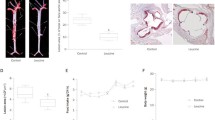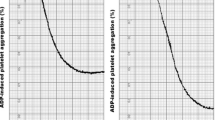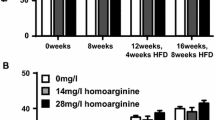Abstract
The aim of this study was to determine the levels of regulatory peptides apelin, glucagon-like peptide (GLP-1) and visfatin in hypercholesterolemic and hyperhomocysteinemic state and to examine their relation with nitric oxide (NO) metabolism. 32 Male guinea pigs were divided into four groups and each group was fed as follows: (a) commercial chow, (b) cholesterol (chol)-rich diet, (c) methionine (meth)-rich diet, and (d) chol + meth-rich diet. Blood samples were drawn at the end of 10 weeks, and abdominal aorta was dissected for histopathological examination. Serum insulin, GLP-1, apelin, visfatin, and nitrotyrosine concentrations were measured by the manufacturer’s kits based on ELISA; asymmetric dimethylarginine (ADMA) and arginine levels were measured by the high performance liquid chromatography. Homocysteine level was measured by the chemiluminescence immunoassay; glucose, total chol and triglyceride levels were measured by the autoanalyzer. The microscopic examination of aorta indicated varying degrees of vascular disturbance in chol- and chol + meth-fed groups. High levels of chol and homocysteine, accompanied with significantly low levels of apelin and GLP-1 were detected in the plasma. Visfatin, ADMA, and nitrotyrosine levels both in chol- and chol + meth-fed groups were significantly higher than those in control animals, whereas arginine and arginine/ADMA ratio were lower. This study indicated that circulating levels of apelin, GLP-1, and visfatin are markedly altered during the development of atherosclerotic changes in close association with chol, homocysteine, NO, and ADMA levels. The measurements of these peptides in serum may help for the diagnosis and follow-up of vascular dysfunction.




Similar content being viewed by others
References
Zulli A, Widdop RE, Hare DL (2003) High methionine and cholesterol diet abolishes endothelial relaxation. Arterioscler Thromb Vasc Biol 23:1358–1363
Boucher J, Castan-Laurell I, Daviaud D (2005) Adipokine expression profile in adipocytes of different mouse models of obesity. Horm Metab Res 37:761–776
Kleinz MJ, Davenport AP (2004) Immunocytochemical localization of the endogenous vasoactive peptide apelin to human vascular and endocardial endothelial cells. Regul Pept 118:119–125
Tatemoto K, Hosoya M, Habata Y et al (1998) Isolation and characterization of a novel endogenous peptide ligand for the human APJ receptor. Biochem Biophys Res Commun 251:471–476
Carpene C, Dray C, Attane C et al (2007) Expanding role for the apelin/APJ system in physiopathology. J Physiol Biochem 63:359–373
Goetze JP, Rehfeld JF, Carlsen J et al (2006) Apelin: a new plasma marker of cardiopulmonary disease. Regul Pept 133:134–138
Tatemoto K, Takayama K, Zou MX et al (2001) The novel peptide apelin lowers blood pressure via a nitric oxide-dependent mechanism. Regul Pept 99:87–92
Saddi-Rosa P, Oliveira CS, Giuffrida FM et al (2010) Visfatin, glucose metabolism and vascular disease: a review of evidence. Diabetol Metab Syndr 2:21
Chen MP, Chung FM, Chang DM (2006) Elevated plasma level of visfatin/pre-B cell colony-stimulating factor in patients with type 2 diabetes. J Clin Endocrinol Metab 91:295–299
Liu SW, Qiao SB, Yuan JS et al (2009) Association of plasma visfatin levels with inflammation, atherosclerosis, and acute coronary syndromes in humans. Clin Endocrinol (Oxf) 71:202–207
Doyle ME, Egan JM (2007) Mechanisms of action of GLP-1 in the pancreas. Pharmacol Ther 113:546–593
Mita T, Watada H (2012) Glucagon like peptide-1 and atherosclerosis. Cardiovasc Hematol Agents Med Chem 10:309–318
Yamaoka-Tojo M, Tojo T, Takahira N et al (2010) Elevated circulating levels of an incretin hormone, glucagon-like peptide-1, are associated with metabolic components in high-risk patients with cardiovascular disease. Cardiovasc Diabetol 9:17
Piotrowski K, Becker M, Zugwurst J et al (2013) Circulating concentrations of GLP-1 are associated with coronary atherosclerosis in humans. Cardiovasc Diabetol 12:117. doi:10.1186/1475-2840-12-117
Coban J, Evran B, Ozkan F et al (2013) Effect of blueberry feeding on lipids and oxidative stress in the serum, liver and aorta of guinea pigs fed on a high-cholesterol diet. Biosci Biotechnol Biochem 77:389–391
Yalcinkaya S, Unlucerci Y, Giris M et al (2009) Oxidative and nitrosative stress and apoptosis in the liver of rats fed on high methionine diet: protective effect of taurine. Nutrition 25:436–444
Matthews DR, Hosker JP, Rudenski AS et al (1985) Homeostasis model assessment: insulin resistance and beta-cell function from fasting plasma glucose and insulin concentrations in man. Diabetologia 28:412–419
Teerlink T (2005) Determination of the endogenous nitric oxide synthase inhibitor asymmetric dimethylarginine in biological samples by HPLC. Methods Mol Med 108:263–274
Sugiyama K, Kumazawa A, Zhou H et al (1998) Dietary methionine level affects linoleic acid metabolism through phosphatidylethanolamine N-methylation in rats. Lipids 33:235–242
Hirche F, Schröder A, Knoth B et al (2006) Effect of dietary methionine on plasma and liver cholesterol concentrations in rats and expression of hepatic genes involved in cholesterol metabolism. Br J Nutr 95:879–888
Woo CW, Siow YL, Pierce GN et al (2005) Hyperhomocysteinemia induces hepatic cholesterol biosynthesis and lipid accumulation via activation of transcription factors. Am J Physiol Endocrinol Metab 288:E1002–E1010
Hansson GK (2005) Inflammation, atherosclerosis, and coronary artery disease. N Engl J Med 352:1685–1695
Li H, Wallerath T, Münzel T et al (2002) Regulation of endothelial type NO synthase expression in pathophysiology and in response to drugs. Nitric Oxide Biol Chem 7:149–164
Szuba A, Podgórski M (2006) Asymmetric dimethylarginine (ADMA) a novel cardiovascular risk factor—evidence from epidemiological and prospective clinical trials. Pharmacol Rep 58:16–20
Böger RH, Maas R, Schulze F et al (2009) Asymmetric dimethylarginine (ADMA) as a prospective marker of cardiovascular disease and mortality—an update on patient populations with a wide range of cardiovascular risk. Pharmacol Res 60:481–487
Landim MBP, Dourado PM, Casella-Filho A et al (2013) High plasma concentrations of asymmetric dimethylarginine inhibit ischemic cardioprotection in hypercholesterolemic rats. Braz J Med Biol Res 46:454–459
Sydow K, Schwedhelm E, Arakawa N et al (2003) ADMA and oxidative stress are responsible for endothelial dysfunction in hyperhomocyst(e)inemia: effects of l-arginine and B vitamins. Cardiovasc Res 57:244–252
Cooke JP, Ghebremariam YT (2011) DDAH says NO to ADMA. Arterioscler Thromb Vasc Biol 31:1462–1464
Bekpinar S, Develi-Is S, Unlucerci Y et al (2013) Modulation of arginine and asymmetric dimethylarginine concentrations in liver and plasma by exogenous hydrogen sulfide in LPS-induced endotoxemia. Can J Physiol Pharmacol 91:1071–1075
Stühlinger MC, Oka RK, Graf EE et al (2003) Endothelial dysfunction induced by hyperhomocyst(e)inemia: role of asymmetric dimethylarginine. Circulation 108:933–938
Jakubowski H, Zhang L, Bardeguez A et al (2000) Homocysteine thiolactone and protein homocysteinylation in human endothelial cells: implications for atherosclerosis. Circ Res 7:45–51
Knipp M, Braun O, Vasák M (2005) Searching for DDAH inhibitors: S-nitroso-l-homocysteine is a chemical lead. J Am Chem Soc 127:2372–2373
Förstermann U, Sessa WC (2012) Nitric oxide synthases: regulation and function. Eur Heart J 33:829–837
Gryglewski RJ, Palmer RM, Moncada S (1986) Superoxide anion is involved in the breakdown of endothelium-derived vascular relaxing factor. Nature 320:454–456
Reiter CD, Teng RJ, Beckman JS (2000) Superoxide reacts with nitric oxide to nitrate tyrosine at physiological pH via peroxynitrite. J Biol Chem 275:32460–32466
Tasci I, Dogru T, Naharci I et al (2007) Plasma apelin is lower in patients with elevated LDL-cholesterol. Exp Clin Endocrinol Diabetes 115:428–432
Karadag S, Ozturk S, Gursu M et al (2014) The relationship between apelin and cardiac parameters in patients on peritoneal dialysis: is there a new cardiac marker? BMC Nephrol 16(15):18. doi:10.1186/1471-2369-15-18
Oyama J, Node K (2014) Incretin therapy and heart failure. Circ J 78:819–824
Avogaro A, Vigili de Kreutzenberg S, Fadini GP (2014) Cardiovascular actions of GLP-1 and incretin-based pharmacotherapy. Curr Diabetes Rep 14:483. doi:10.1007/s11892-014-0483-3
Noyan-Ashraf MH, Shikatani EA, Schuiki I et al (2013) A glucagon-like peptide-1 analog reverses the molecular pathology and cardiac dysfunction of a mouse model of obesity. Circulation 127:74–85
Ding L, Zhang G (2012) Glucagon-like peptide-1 activates endothelial nitric oxide synthase in human umbilical vein endothelial cells. Acta Pharmacol Sin 33:75–81
Shiraki A, Oyama J, Komoda H et al (2012) The glucagon-like peptide 1 analog liraglutide reduces TNF-α-induced oxidative stress and inflammation in endothelial cells. Atherosclerosis 221:375–382
Kadoglou NP, Gkontopoulos A, Kapelouzou A et al (2011) Serum levels of vaspin and visfatin in patients with coronary artery disease—Kozani study. Clin Chim Acta 412:48–52
Vallejo S, Romacho T, Angulo J et al (2011) Visfatin impairs endothelium-dependent relaxation in rat and human mesenteric microvessels through nicotinamide phosphoribosyltransferase activity. PLoS ONE 6:e27299
Gunes F, Akbal E, Cakir E et al (2012) Visfatin may be a novel marker for identifying stages of essential hypertension in advanced age patients. Intern Med 51:553–557
Uslu S, Kebapci N, Kara M et al (2012) Relationship between adipocytokines and cardiovascular risk factors in patients with type 2 diabetes mellitus. Exp Ther Med 4:113–120
Acknowledgments
This study was supported by the Research Fund, Istanbul University, Project No. 22342.
Author information
Authors and Affiliations
Corresponding author
Rights and permissions
About this article
Cite this article
Kusku-Kiraz, Z., Genc, S., Bekpinar, S. et al. Circulating levels of apelin, glucagon-like peptide and visfatin in hypercholesterolemic–hyperhomocysteinemic guinea-pigs: their relation with NO metabolism. Mol Cell Biochem 400, 69–75 (2015). https://doi.org/10.1007/s11010-014-2263-4
Received:
Accepted:
Published:
Issue Date:
DOI: https://doi.org/10.1007/s11010-014-2263-4




